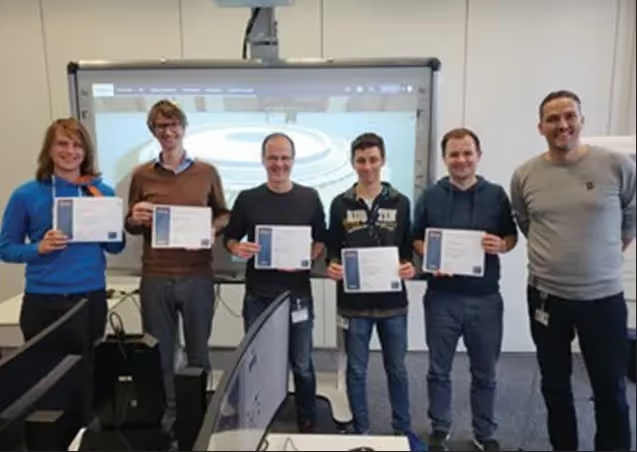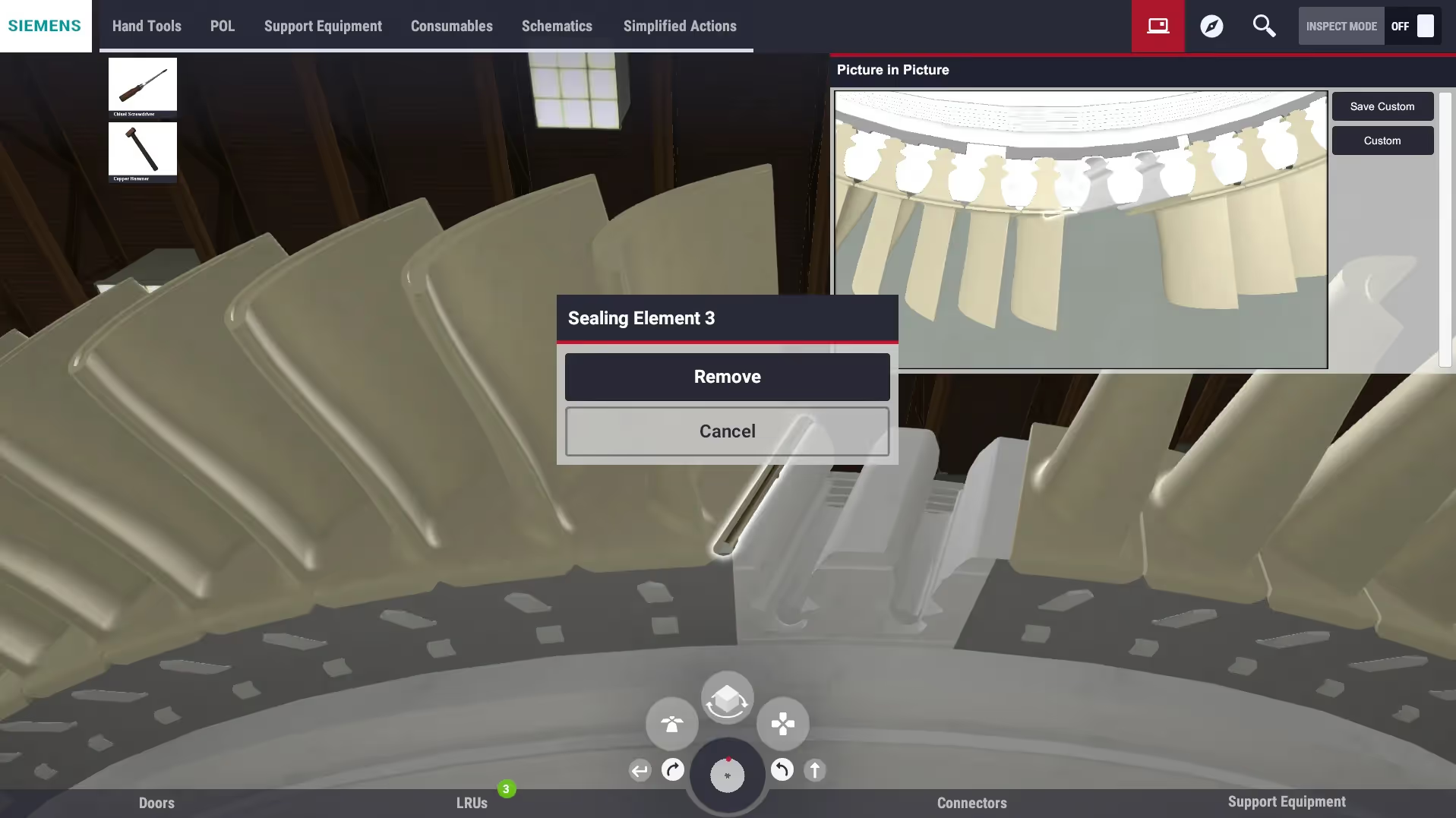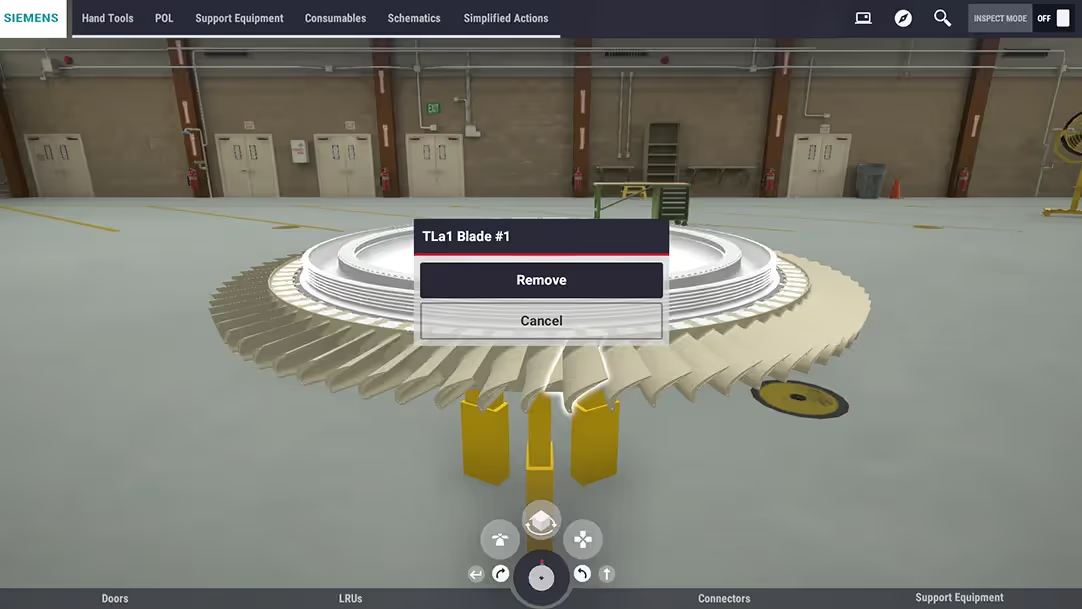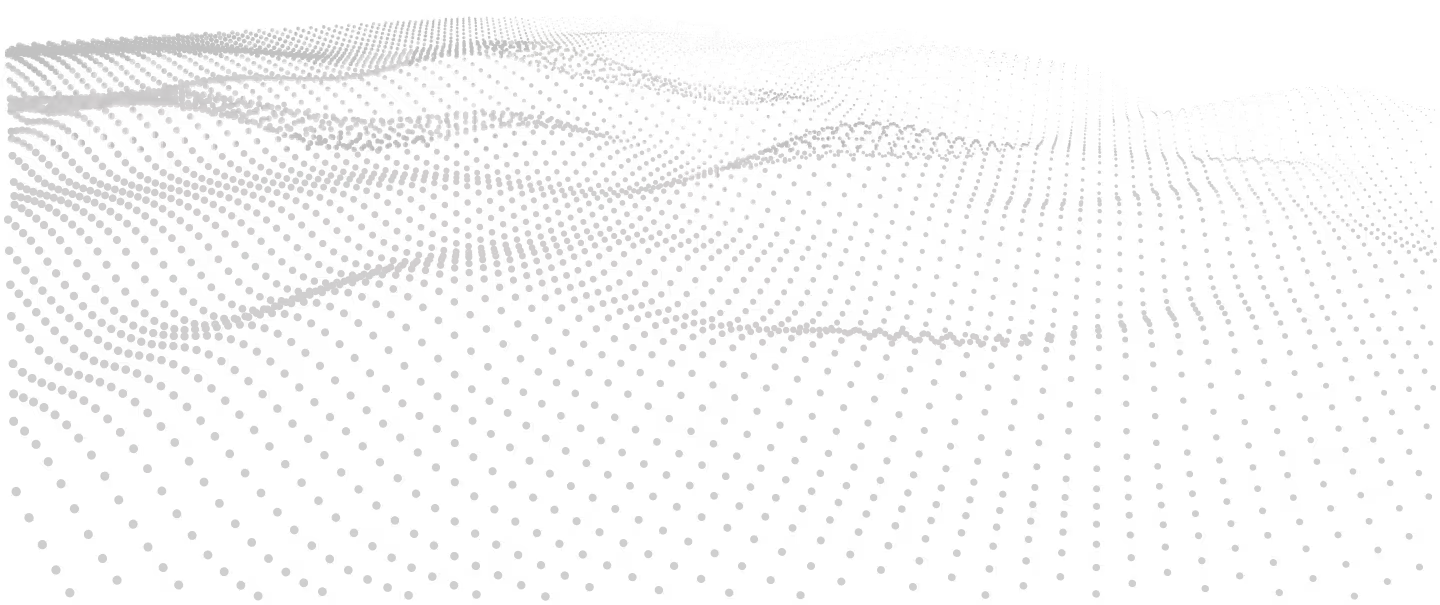Siemens Power Generation Services selects virtual training solutions developed with VE Studio by DiSTI for its global gas turbine business.
Challenge
- Reduce travel and logistical costs for training
- Offer asynchronous training for global workforce
- Create new interactive training methods for the nextgeneration of employees
Solution
- VE StudioTM virtual training development platform
- DiSTI Professional Services
- Desktop, Virtual, Augmented Reality applications
- Amazon AppStream for enterprise deployment
Impact
Increased student throughout
- Improved training efficiency and student efficacy –greater than 66% reduction in classroom training time;initial assessment scores of 93% on average.
- Proven reduction in training costs
- New training business mode
As a leader in the global power generation market, Siemens products provides an estimated 30% of the world’s power generation. With growing demand in developing markets they need to continuously modernize training and take advantage of new technologies to enable staff and customers to service and maintain equipment more efficiently and cost effectively.Digitalization is a top priority for Siemens and training is an area where technologies such as virtual reality, augmented reality, and cloud services are being used to create new digital models of training and field services. According to Kevin Carpenter, Director of Global Operations Training Network for Siemens Energy Inc., “Our global business is constantly evolving and one of the biggest challenges we face today is the changing demographic of our global workforce. A large portion of our existing workforce is retiring and we need to hire new technicians and train them faster and more efficiently”.
One challenge is that new workers are often not in the same geographic locations as the existing workforce. New technologies such as cloud services, virtual reality, and augmented reality will enable Siemens to accelerate the process of training new staff in distributed locations.With employees on nearly every continent, the challenge for Siemens was finding a way to leverage virtual technologies to improve training in a scalable and costeffective manner for their global workforce. The solution was to digitalize training so it is accessible by workers at any time and at any location.
The Training Challenge
Training field service engineers to service power equipment is a highly complex and lengthy process. Historically, all new technician training was done via a combination of classroom training and hands-on training at one of Siemens’ global training facilities. According to Carpenter, “The process to train a field service engineer is complex and time consuming. It requires a combination of theoretical courses combined with immediate hands-on practice with instructors in the training centers as well as on the job site so that engineers can perform the tasks required. We need to distribute training, however, the biggest challenge we are faced with is the need to conduct the training in the facilities where physical equipment is installed. The sheer cost of the equipment and its maintenance makes it difficult to distribute training using traditional training methods.”Another challenge Siemens has with physical training is the throughput or training capacity at a training facility.
There are a fixed number of students that can receive hands-on training at any given time on physical equipment, a number that can’t be increased without adding additional facilities. They wanted to find a way to increase student throughput without adding facility and equipment costs.There are also high costs of travel for training. With thousands of technicians requiring training every year, the travel costs alone are significant. That reduction of time required at the training facility translates to direct savings both from a travel and time away from the job perspective.Besides in-plant training, Siemens also offers other training courses where instructors are sent to remote locations. According to Mike Kovacs, Technical Training Manager for Siemens, “We train employees on how to service power plants located nearly everywhere around the world, and the equipment is constantly evolving and our training content requires frequent updates.
This type of training is usually done by flying them in for a three or five day training seminar. We move people around and either send trainers to them or bring the technicians to the trainers which becomes costly. We are always looking for opportunities to reduce both travel costs and time away from work for both our instructors and students.In 2009, Siemens began rethinking the way training was developed to find ways to improve the quality of training, reduce costs, and innovate the instructional process. One of the solutions identified was virtual training technology. According to Mike Kovacs, “We knew virtual technology provided a way for us to create interactive training, but we did not have the capabilities and expertise in house to develop the software solutions required, so we searched for companies that had both technology and skills to assist us. We selected DiSTI Corporation because they have extensive experience developing virtual training solutions for the aerospace and defense industry. They also provided the VE StudioTM virtual training development platform which Siemens could use internally to develop and manage their own virtual training content. The initial project was to develop a simple virtual procedural trainer for our steam turbine engines.”
DiSTI considers VE Studio as a comprehensive “virtual training solution-in-a-box” – a development platform for projects where time and efficiency are critical to program success.
Virtual Training Development with VE Studio
VE Studio is a comprehensive 3D virtual training development platform that includes a suite of tools to enable users to develop end-to-end virtual training solutions. Designed to be a “virtual training development solution in a box”. DiSTI has also developed a patented methodology in which to import various types of graphical and procedural data into a relational database called the Fidelity MatrixTM (FM). The Fidelity Matrix then forms the core data set for the entire training solution that builds on the power of commercial game engines to develop the runtime package.By using the source data directly in the virtual maintenance trainer (VMT) creation process, DiSTI believes a foundation of traceability and stability is created that resonates throughout the entire VMT, making late project changes, or future product updates easy to accommodate and to republish the content easily and efficiently. By using VE Studio, Siemens was able to reduce development by 50% compared to manual hand-coding development processes commonly used in virtual training system development.For example, the VE Studio Requirements Analyzer imports the massive amounts of procedural documentation into the database electronically, eliminating time consuming and sometimes error prone manual entry, while also establishing source-toobject relationships that are used throughout the other VE Studio applications.VE Studio’s Max Link tool relates models from 3dsMaxTM with objects in the Fidelity Matrix database. The Fidelity Matrix Editor is the database front end that links objects and associated models, providing the relationships between the models and how they should act in the Virtual Environment. DiSTI believes that using the relational model within the Fidelity Matrix makes systems development efficient, since a change to objects only needs to be made in one place, which is then propagated throughout the system.
The culmination of the VE Studio workflow is the Training Assistant, which provides the end user’s entry point to the Virtual Environment in the form of student and instructor stations with lesson authoring capabilities, student management, and reporting. VE Studio utilizes a commercial rendering engine to create the runtimes destined the for class room desktops, mobile applications, or integrating VR and AR experiences all from the same data set within the Fidelity Matrix. According to DiSTI, the combination of VE Studio and a commercial rendering engingemakes it easier to develop high quality, high-resolution and portable runtime applications tailored to the objectives of the course, its content and the student’s experience to create an immersive and effective course that improves student retention and effectiveness in the field.
Going from Pilot to Production
Since the first project in 2009, Siemens has continued to develop virtual part task trainers for various power products. Then in 2017, they took a big step forward and developed a full production VMT for their largest power plant, the SGT-8000H heavy-duty gas turbine. According to Mike Kovacs, “Based on the success we had with the previous virtual training solutions developed with VE Studio, we were confident we could develop a virtual maintenance trainer for our largest and most complex power plant equipment and this could be a game changer for our business.”
DiSTI considers VE Studio as a comprehensive “virtual training solution-in-a-box” – a development platform for projects where time and efficiency are critical to program success.
Mike Kovacs, Technical Training Manager for SiemensAt the same time, Siemens was looking for new ways to take advantage of virtual and augmented reality technologies enabling them to apply training in different ways than just through a desktop computer. Before they could execute on that vision, the first step was to create a complete replica or ‘digital twin’ of the gas turbine; including all the training content and procedures produced when the turbine was designed and built along with subsequent updates.Phase one addressed three complex inspection procedures for this turbine comprising over 500 steps. The traditional hands-on training course takes five instructorled days on the physical turbine to teach and assess the student. With the new VMT, this course now takes approximately eight hours of self-paced exploration and assessment for a novice student and two to three hours for students already familiar with turbine equipment.
According to Kovacs, “Each student can now learn at their own pace and there is no longer a requirement for the instructor to lead the training as all of the course materials are interactive and self-guided. The role of the instructor has changed from teaching from the front to being a facilitator and subject matter expert to assist students with more complex questions and tasks.”Siemens has also seen significant learning improvements with initial assessment scores averaging greater than 93% which is a significant improvement over traditional classroom training. The results are attributed to the VMT’s multimode learning capability which allows students to explore and practice the procedures until they achieve a sufficient level of mastery. There are four modes available to students:
- Autoplay Mode (Watch and Learn) – This mode shows the student all of the procedures and steps without any interaction required from the student. Similar to watching a video.
- Tutorial Mode – This interactive mode goes through the steps and guides the student through the procedures. They have to follow the prescribed steps in the correct order and timing sequence.
- Practice Mode – This mode allows the student to go through the procedures on their own but provides assistance when required. The mode also tracks the progress and actions and provides both the student and instructor various reports.
- Assessment Mode – This mode is similar to the real world where the student can perform any action physically possible on the equipment. The system tracks and scores the student and provides detailed reports and an automated assessment.
Kovacs adds, “People learn in different ways and the VMT with the various modes really allows students to absorb new content the way they are most comfortable with and to practice as much as required to learn a procedure. The SGT-8000H VMT provides the student with the ability to repeat the lessons until they can master the procedure – at their own pace – without utilizing physical equipment or instruction resources.”Siemens’ first full-scale VMT project reduced classroom time, increased student throughput rates, and improved learning outcomes while also reducing overall training costs. Siemens considers this is a real win for their business.
One interesting request that Kovacs received from the field engineers who attended training was to explore how they could have access to the VMT applications with them while onsite so that they could use the content as refresher training prior to service outages or repairs. “It makes complete sense because the VMT is designed to be a full replica of the actual power plant, however this would require that field service engineers be equipped with high power laptops that could run the VMT applications. We knew there had to be others ways so we engaged with DiSTI to explore possible cloud deployment options”, said Kovacs.
“Delivering over AppStream 2.0 was the real game changer that we were looking for, we were able to deliver on our vision of anywhere, anytime maintenance training.”
Mike Kovacs, Technical Training Manager for PSPG
From the Classroom to the Cloud
The first version of the SGT-8000H VMT was delivered as a portable classroom solution, which was comprised of pre-configured instructor and student laptops in a portable travel case, along with Augmented Reality Glasses. This allowed instructors to take the training on the road and deliver in any facility. While this provided much needed portability, there was still a need to deliver courses to any Siemens employee virtually anywhere in the world and at any time. The technical challenge that needed to be solved was how to equip workers with the high powered and expensive gaming computers required to run the virtual training applications.The DiSTI VE Studio team collaborated with Siemens to solve this by enabling asynchronous training in an Amazon AppStream 2.0™ environment. AppStream 2.0 is a cloudbased service where complex graphics processing is executed in the cloud and delivered via a standard internet browser.
This means Siemens employees can use any browser to access the Virtual Maintenance Trainer.According to Kovacs “It took us about one week to modify and load the VMT to our own internal Siemens AppStream instance with minimal development effort because of the way the content was originally developed with VE Studio. We enabled the VMT applications to allow asynchronous training through the Siemens Intranet which provided employees with the necessary access and security. This made it possible for us to deliver the courses to anyone at their premises around the world. It has completely transformed our training program”.Siemens is now focused on creating more virtual training courses to be delivered via AppStream 2.0 and integrating the courses with its internal Learning Management System so that employee development can be managed across their enterprise.
Desktop, Tablet, VR or AR – Which is the Right Path?
Virtual training delivery encompasses a variety of technologies including desktop, mobile, VR and AR
Comparison of Various VMT Deployment Technologies
Below is a table that provides some comparison to the use of various technologies for VMT development:

Virtual training delivery encompasses a variety of technologies including desktop, mobile, VR and AR delivered on premise or via the cloud. A robust platform will allow content to be adapted and deployed to different technologies without having to rewrite the source code.Siemens initially developed the technology for desktop use, however, they recognized that tablets and Virtual and Augmented Reality technologies provided additional capabilities and advantages to support the desired training outcome. Their goal was to select a company and a development platform that would enable development to any technology and would not require extensive redevelopment as the device technologies evolve.
DiSTI recommends that once an organization has determined which technologies it wants to leverage for training it should then consider the training development platform to be used. Given that virtual training is constantly evolving it is important that the development platform supports many different technologies available presently, but is also adaptable to new technologies as they emerge.Carpenter states, “When we started our development efforts, both AR and VR were still early stage technologies but we knew they are important for our future. Therefore, we developed content for both technologies and are integrating them into the courses to supplement the desktop training.”
For example, there are some procedures that are very complex and better suited for virtual reality after learning the procedure through a desktop course. However, in our experience some training is better while physically with the equipment in which case augmented reality is a better choice as the student can work on the physical equipment while seeing information via the AR glasses. AR is more mobile than Desktop or VR, and also allows for hands-free interaction. In other cases, tablet- based applications are more suitable at the plant sites as technicians can replay the interactive content on the screen and see the procedures played back in the proper order – similar to having an electronic checklist with videos. The point is that all these technologies need to draw from the same source content which is based on the manufacturer’s procedures.
For Siemens, that content will reside in the VE Studio Development Platform which is where the CAD models from Siemens Teamcenter™ are combined with the operational and maintenance procedures. Once the data is in the VE Studio FM database, it is available to develop training for the next technology.According to DiSTI, VE Studio aids internal resources by eliminating the need to recreate training content for every new course developed and published. Because VE Studio utilizes the power of the FM database to create a single consistent dataset, that same content can be modified, re-used and re-deployed to classroom, mobile, VR, AR, and desktop platforms. This allows Siemens to match the student experience to the best delivery modality and allows their training to scale across the enterprise.
VE Studio® Reduced Development Time and Cost
Initially, Siemens anticipated that development of the virtual training for the SGT-8000H heavy duty gas turbine would have taken 18 months using a manual coding approach. With the VE Studio Development Platform, Siemens was able to use models and procedure manuals from the current training along with predefined templates and modules to incorporate in to the development platform, cutting the development time down to 8 months from start to finish. As Siemens has become more familiar with the processes and tools, they have been able to reduce development time even further to where they are now able to complete projects in as little as 3-4 weeks depending on the complexity of the project.

Importance of Technology Collaboration
Kay Weber, Executive Vice President of Siemens Power Generation Services, states “As a leading global industrial company we know that technologies constantly change, and it is important to collaborate with leading technology companies so we can take advantage of new developments and technology as they are available. These collaborations also ensure we have a way to communicate our needs to help us drive our technology roadmaps more effectively.”Siemens recognized the importance of virtual and augmented reality and realized that they needed to start working with technology providers to learn faster and to collaborate for creating new industry solutions.
HP is one of Siemens’ largest IT equipment suppliers and is also a leading innovator in virtual reality with new technologies that make the process of developing and deploying virtual reality solutions more efficient and scalable. In 2018, Siemens began a global technology collaboration with HP and DiSTI to facilitate the development of new solutions to address areas in the energy industry that Siemens felt VR technology could benefit their customers. This included creating training modules for the SGT-8000H VMT using the HP Z Backpack Workstation with Windows Mixed Reality Head Mounted Displays. The HP VR Backpack Siemens enables students to take advantage of immersive training without having to be tethered to a workstation, thus providing additional mobility and capability. This has opened up new application areas that Siemens had not previously considered.
SGT-8000H VR prototype using HP’s Z-Backpack for mobile VR training
Siemens, HP and DiSTI are also collaborating to open demonstration and innovation centers around the world showcasing solutions for customers and providing development workstations for teams working to co-create new digital solutions. In October 2018, the Technical Education and Competency Center was opened at Siemens in Berlin, Germany. The 300 square meter facility is fully equipped with HP Workstations and VR equipment, VE Studio software and other tools such as Siemens Teamcenter, Unity and 3dsMax to facilitate courseware development and testing. Siemens plans to replicate this model around the world.

First training team to receive VE Studio Certification at the Technical Enablement Competency Center in Berlin, Germany
Global Development
Siemens needs to develop and deliver training applications globally. While the first project for the SGT-8000H was developed in the United States, another VMT development program for the SGT-4000F gas turbine was developed in Europe which is where that product is manufactured. Siemens was able to streamline their development process and shorten the delivery cycle by leveraging the VE Studio development platform and the processes that had already been developed for the previous projects.According to Kovacs, “Because of the timelines we wanted to achieve, we contracted development of the SGT-4000F to a European services company, to develop the SGT-4000F using VE Studio with training and assistance from DiSTI. We were able to provide the supplier with the models from Siemens Teamcenter along with the procedure manuals for the SGT-4000F in order to develop the VMT with our internal project team in Berlin.
The user experience and functionality of the SGT-4000F is identical to the SGT-8000H and was developed in only 6 months.The VE Studio platform facilitated the establishment of a global, secure distributed development architecture to enable development activities and information sharing between teams in the U.S. and Europe. “It is like we are one integrated team” said Kovacs. “We are confident that we are able to develop training for any product we manufacture quickly and cost effectively”.
The Future – Digital Disruption for Field Service Teams
Virtual training is now a standard business practice for Siemens and they are now expanding development to all major product lines as well as expanded capabilities to push “beyond classroom training” to provide real time “point-of-need” training and field service delivery. The application of this blends the role of training with that of remote field services. This is an area where AR has significant potential.While VR training involves being completely immersed in a virtual world in which the student is repairing a virtual replica of their equipment, AR provides the capability to view an augmented content overlay superimposed onto actual equipment. According to Carpenter, “We are now referring to this capability as Guided Assist, where we can use the training content to provide real world assistance to a technician who is either preparing to conduct a procedure or where a technician is learning new content.
”The AR overlay can serve many purposes for the student or technician, including showing the next steps of a specific procedure or highlighting pieces on the equipment that require action. Since all content used by VE Studio originates from the same database, the content only needs to be created once and then it can be pushed out to multiple devices. This process not only saves on development time but allows for the easy deployment of new content going forward.“Guided Assist, where we can use the training content to provide real world assistance to a technician who is either preparing to conduct a procedure or where a technician is learning new content” Kevin Carpenter, Director of Global Operations Training Network

Utilizing different technologies to train employees enables Siemens to revolutionize their training model. The flexibility of VE Studio as a development platform facilitates Siemens’ development of their own training content using their own staff – a key differentiator from the traditional training development model which required outsourcing to software development companies. In the future, there are plans to create new training for employees and customers based on virtual technology. Whatever path they choose in the future, Siemens has laid a solid foundation to enable them to scale virtual training across their entire global enterprise.

Courseware development for the SGT- F – aligning animation and lesson authoring


.avif)

.svg)


.svg)

